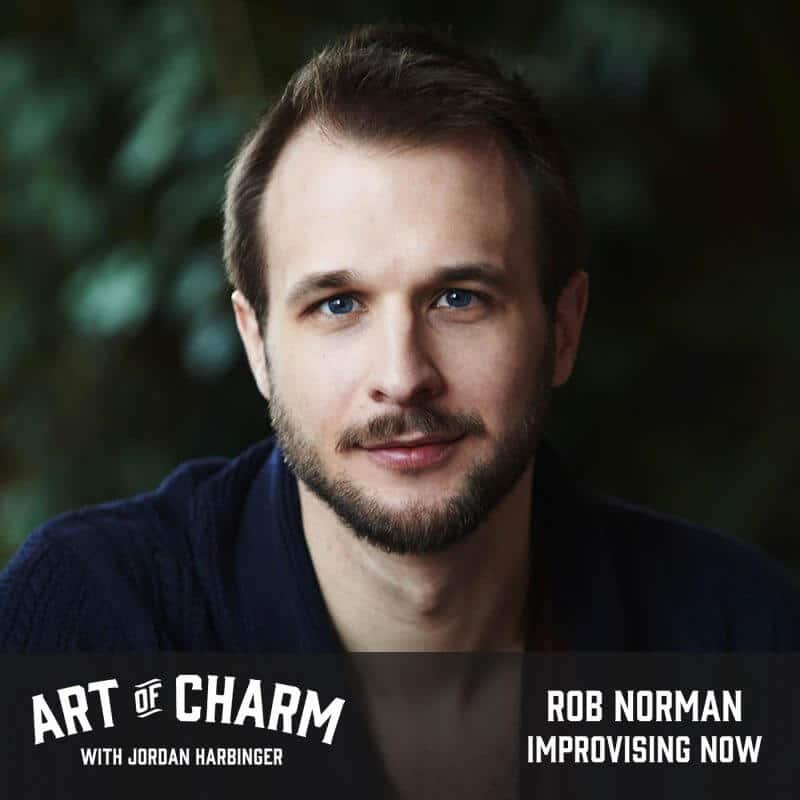Rob Norman (@robthenorman), co-host of The Backline podcast and author of Improvising Now, explains how we can use techniques from improvisational theater to conquer everyday life challenges.
The Cheat Sheet:
- Improvisational theater skills go far beyond just helping us think quickly on our feet.
- In improv, as in all spontaneous life experiences, failure is a possible outcome. Sharpening improv skills gets us not only to overcome our fear of failure, but to learn from it.
- Learn how the “yes…and” exercise fosters positive interaction, teamwork, and better ideas not only with improv scene partners, but with people in our business and personal lives.
- Use the Last Line Response exercise in conversation as a powerful way to show that you’re paying attention — and elicit attention in return.
- No matter how experienced you are at something, confidence is an illusion. It’s knowing how to respond when something goes wrong without spoiling that illusion that makes the difference.
- And so much more…
[aoc-subscribe]
According to Second City veteran and author of the book Improvising Now: A Practical Guide to Modern Improv Rob Norman, improvisational theater skills are life skills. Agreement, support, listening, and embracing the unknown are all challenges we face on a daily basis. Improvisers master these skills to create comedy out of nothing; business professionals can learn these skills to create a more cohesive supporting working environment.
In episode 516 of The Art of Charm, we talk to Rob about how we can apply these skills to tackle our own daily challenges in any walk of life. For listeners who want to expand their improv chops, we recommend checking out The Backline, the weekly improv podcast Rob co-hosts with fellow comedian Adam Cawley.
More About This Show
If you’ve ever seen the classic television show Whose Line Is It Anyway?, you have an idea of what improvisational theater entails. A performer — or group of performers — goes on stage and crafts a scene with a random idea provided by the audience. There are no scripts. Performers have to think on their feet and work together to react to whatever journey that random idea generates. And while it’s true there’s no way to prepare for the specifics of a scene beforehand, there’s plenty of preparation that goes toward honing the improv skills that make pulling off such scenes possible.
A lot of it goes toward being comfortable enough with the idea of failure that it doesn’t cripple the will to consider unexplored options and try new things. In improv, as with all things in life, nothing is certain — and that’s okay.
“If you play in a way where you have no idea what’s happening and you’re okay with the idea of failure,” says Rob Norman, author of Improvising Now: A Practical Guide to Modern Improv and co-host of The Backline podcast, “then there’s the potential of a great thing happening. And even to this day — I’ve been improvising for 10 years — I cannot guarantee if I go onstage I’m not going to bomb terribly. That’s part of the deal. The good news is, as you get more experienced doing improv, the ratio goes down.”
Rob says that, in contrast to the freezing sensation most of us experience during a major failure, he lives for the one in 10 times one of his scenes bomb on stage. “When they’re terrible, I enjoy the bomb. I love being on stage and watching a hundred people in the audience be like, ‘That really funny guy is not doing well right now. Should we help him? How do we help him?’ That’s part of the joy of improv.”
Improvising with “Yes…And”
When collaborating with a scene partner on a newly introduced scene idea, it’s important to help each other build on that idea. So when your partner says, “Let’s go see a movie,” resist any urge you might have to take the scene in a completely opposite direction. Instead, say something like, “Yes! Let’s go see a movie and I’ll buy the popcorn!” In turn, your partner responds in a similar “yes…and” fashion, which builds on what you’ve established. And so on.
“If I can take your idea and add onto it, it makes us together as a team more powerful than us trying to be different as individuals,” says Rob.
You’re both trying to get to a destination safely, but you’ve each got a hand on the steering wheel. Working together with “yes…and” will get you there; erratically yanking the wheel to your side will only steer you into a ditch.
This works in relationships — business and personal — too.
“When we’re doing any kind of idea generation,” says Rob,” whether that be a think tank or even something as simple as, ‘Oh, what are we going to get for lunch today?’ often what we end up doing is we combine the editing process with the creation process — and that’s where conflict comes from.”
Instead, we should try to generate as many ideas as possible during an initial brainstorming creation process, saying “yes…and” to whatever proposals are being thrown around the room instead of shooting them down with a negative “no…because” or “yes…but” response. This allows everyone who wants to contribute a chance to voice their ideas without getting turned down immediately or elbowed out by others in a stage of the game that’s suddenly competitive when it should be collaborative.
In this way, everyone has their say without talking over the next person to either be heard or defend a position. We wait to evaluate the results of these ideas and whittle them down in a secondary editing process, which evaluates the consequences of these ideas in a way that more likely avoids conflict and ends up benefiting the whole team over the ego of just one or two participants.
“Great! We have a whole bunch of ideas,” says Rob. “Now once we’ve had all of those ideas generated, now we can choose the best one as opposed to trying to bring an idea to the table and at the same time talk about its merits.”
Rob tells us that, in improv, it’s not his job to be the funniest person on stage. It’s his job to find the funniest thing on stage and support it. This holds true for any situation that demands an element of teamwork.
Improvising Teaches Us to Listen (Last Line Response)
“How much of our time is spent thinking of what we’re about to say when someone else is talking?” says Rob. “It’s a lot. And people can tell when you’re present with them and when you’re off somewhere else.”
To counter this tendency to mentally wander elsewhere when we’re in conversation with others, we can employ an improv exercise called Last Line Response. Simply put, we take the last few words of what someone’s said to us in a conversation and use them in our response. Example:
Improv Partner One: “On our honeymoon, my wife and I fell in love with the cuisine of Portugal.”
Improv Partner Two: “Oh! What did you love about the cuisine of Portugal?”
“When people feel listened to…like you’re there with them,” says Rob, “they’re more willing to be vulnerable with you and they’re more willing to listen to you.”
When we integrate this idea into everyday conversation, we also get better at trying to understand people who have conflicting ideas instead of bombastically reacting to them in a way that benefits neither party. And in showing that we’re willing to listen to what they have to say, it opens them up to listen to what we have to say. It expresses confidence over the neediness of being right.
“The idea of allowing yourself to consider someone else’s perspective…it’s a very powerful place to play from,” says Rob.
Listen to this episode of The Art of Charm to learn why confidence is an illusion (but knowing how to respond when something goes wrong without shattering that illusion is a skill), how improv turned Rob from someone who had social anxiety and was always bored at parties to an engaged listener who became the life of those same parties, how taking ownership of a difficult conversation can be an adventure instead of an ordeal, how shedding judgment (of ourselves as well as others) puts us in the frame of mind to operate at our best, how embracing the concept of group mind helps us overcome ego for the good of the whole, play versus critical thinking, and lots more.
THANKS, ROB NORMAN!
Resources from this episode:
- Improvising Now by Rob Norman
- The Backline – An Improv Podcast
- Facebook fan page for The Backline Podcast
- The Backline podcast at Twitter
- Rob Norman at Twitter
You’ll also like:
- The Art of Charm Bootcamps
- Best of The Art of Charm Podcast
- The Art of Charm Toolbox
- The Art of Charm Toolbox for Women
On your phone? Click here to write us a well-deserved iTunes review and help us outrank the riffraff!




